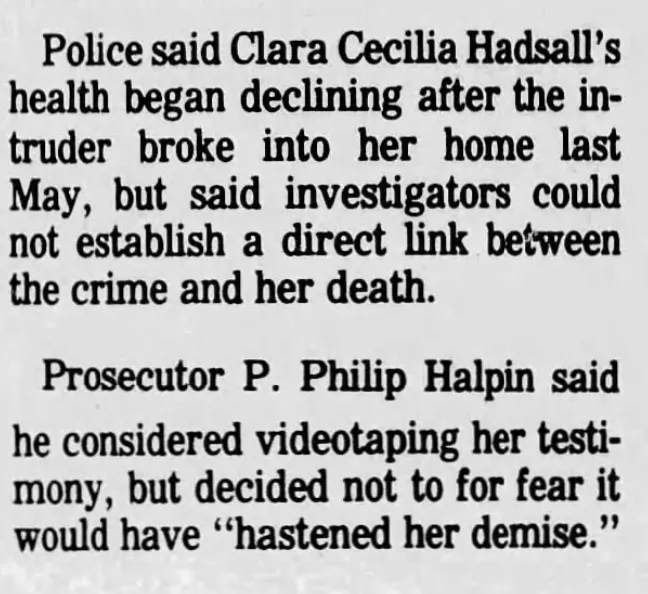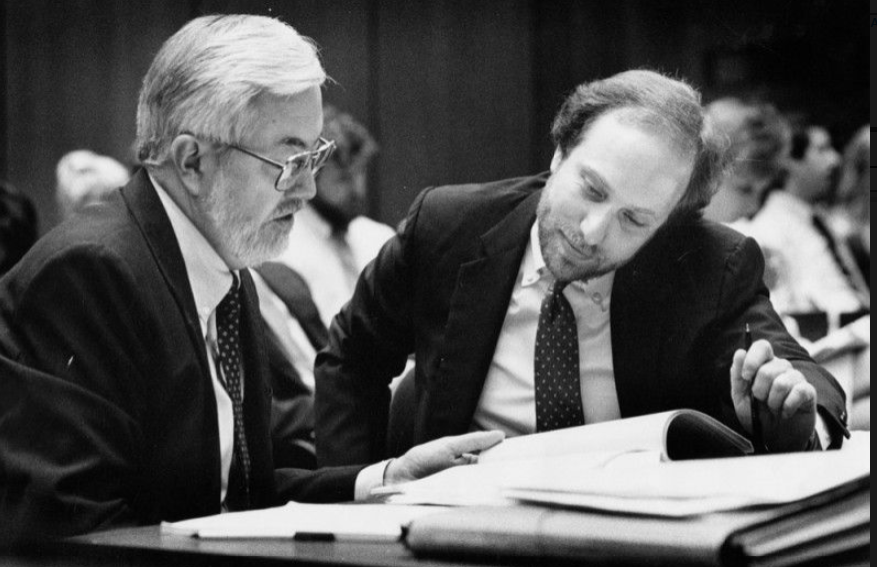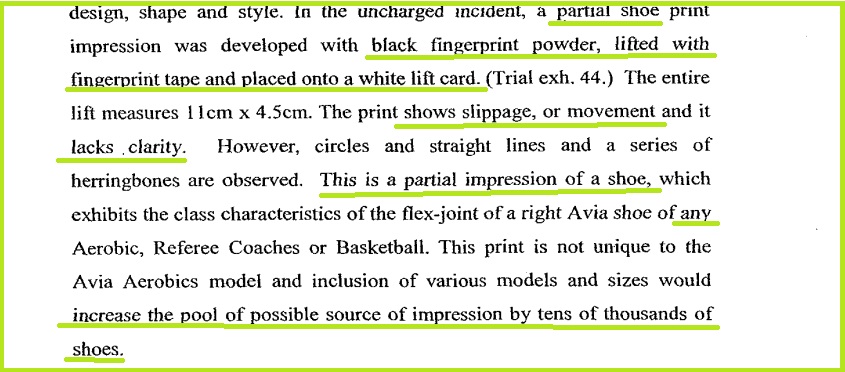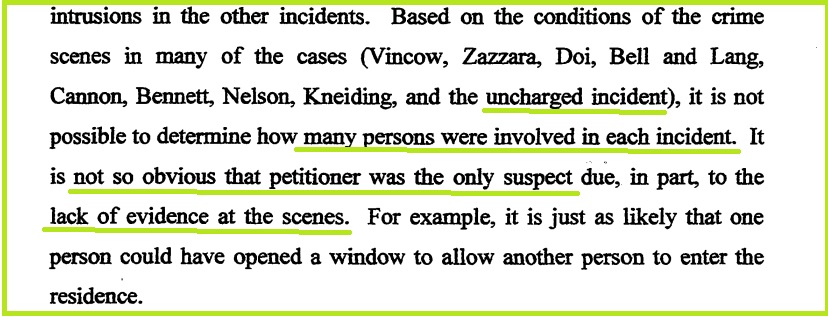*images may need to be viewed on a desktop due to size*
“It should be noted at the outset that no suspect Avia shoes were obtained in this case and no scientific correlation between Avia shoeprints and petitioner Richard Ramirez exists.”
Supplementary declaration of Forensic Specialist Lisa DiMeo

We had hoped never to have to talk about those Avia shoes again, but I fear I must go there one more time and discuss the mysterious Uncharged Incident—the break-in at the home of Clara Hadsall, 9th May 1985.
Out of all the incidents in the Night Stalker case, the robbery of Clara Hadsall gets the least attention, although it was a significant part of the process that led to convictions on all 43 counts.
If the Hadsall incident was so crucial to the prosecution’s case against Richard, why was it uncharged? No crime report is attached to any court documents, Hadsall gave no testimony or witness statement that has been made public, and law enforcement did not call her to the identification line-up. The episode itself does not appear to have been reported in the news when it occurred, possibly because she wasn’t attacked, and robberies and break-ins were prevalent, with 685 reported residential burglaries in Monrovia in 1985 alone. The earliest that the police linked Richard to this crime seems to have been in September 1985, after his arrest.
What Happened?
“In a second attack that had not previously been publicized, Ramirez was accused of robbing and burglarizing the Monrovia home of 85-year-old Clara Cecilia Hadsall on May 9. The woman, who was living alone, told authorities that a man appeared in her bedroom at 2:30 a.m., shined a flashlight in her eyes and robbed her of cash and jewelry.”
LA Times 4th September 1985
Clara Hadsall wasn’t attacked or injured, and her stolen items are never mentioned in the property identification, which occurred on the same day as the live line-up on 5th September, the day after the news report. By 4th September, Richard had, as yet, only been linked to the Doi incident, a very different, horrific crime, which occurred on 14th May.

Neither Lillian Doi, who survived her attack, nor Clara Hadsall, who wasn’t attacked, were called to testify. Prosecutor Halpin stated he thought about videotaping Ms Hadsall’s testimony, then decided not to, in case it “hastened her demise”. As Clara passed away on October 8th 1985, we can assume that by this stage, her health was failing, and although they tried, officials found no link to pin her demise onto Richard Ramirez. Ms Hadsall passed away from natural causes.




A brief outline of the uncharged incident can be found on page 96 of the 2008 habeas corpus petition.
“On May 9th 1985 Monrovia Police Officer, Thomas Wright, responded to a call at 424 West Olive Street in Monrovia, LA County. Officer Wright found that louvers were removed from the kitchen window; a patio chair pushed against the wall. Officer Wright dusted for fingerprints and lifted several prints and a shoe print from the kitchen sink and a fingerprint from the kitchen awning. A shoe print on the patio that could not be lifted matched the tread pattern of the shoe print found on the sink”.
Page 96 – writ of habeas corpus
That is the extent of the information concerning this break-in and at first glance, it doesn’t look particularly unusual. That is until you ask why a regular officer called to a routine break-in had all the forensic equipment with him.
The Enterprising Officer with the Best Equipped Car
In a slightly unusual scenario, Officer Wright, on discovering the alleged break-in, observed shoe prints and palm prints on the sink; rather than call in the people specifically trained to do the crime scene investigation, he took it upon himself to take control of the situation. He gathered all the evidence alone, using a forensic kit he just so happened to have in the trunk of what seems to have been the most well-appointed cop car in history.
The usual course of action, one imagines, would be to see to the property resident, who though not injured, was 85 years old, and call in the personnel trained in crime scene investigation. Not in this case. Not in the “uncharged incident”, the one where no one was injured, where the Night Stalker, who the prosecution has told us, didn’t leave fingerprints because he always wore gloves, left those gloves at home for the evening, and most bizarrely, and most conveniently, planted his whole palm right next to his footprint. How very obliging of him.
In his book “The Night Stalker: The Life and Crimes of Richard Ramirez”, Philip Carlo had this to say. I don’t usually quote anything from Carlo, but this is interesting.
“Officer Wright found a palm print on the sink that had left a latent impression, which Officer Wright had lifted with a fingerprint kit he kept in the trunk of his police car. As well as lifting the palm and fingerprints he found around the sink, he had lifted the footprint right out of the sink using extra–long lifting tape and cards. Officer Wright stated he also found footprints in the dirt on the north side of the house and made plaster casts of those prints too.“
The Life and Crimes of Richard Ramirez the Night Stalker – Philip Carlo
Plaster casts? That is a specialist job requiring precision, training, and knowledge. Even Gerald Burke, the prosecution’s “expert witness“, did not have the necessary training for this work, as his inaccurate findings showed.
Are we really to accept that the diligent Officer Wright carried out this work and (allegedly) photographed it all, without the need to call in the forensics team? It’s worth pointing out that plaster casts are not mentioned in the 2008 petition, only that he lifted prints using powder and tape. Clara Hadsall was no longer around to give her version of events.
Uncharged

The prosecution had a challenging task; the lack of evidence at crime scenes meant difficulties placing him at the locations. In a peculiar turn of events, they decided not to charge him with the ONE and only incident where they allegedly had both shoe imprints and latent fingerprints, although it would still be introduced to the jury. The defence moved to have the case dismissed as inadmissible, but Judge Nelson was having none of that
The motion to dismiss was denied, as according to the prosecution, it showed the propensity of the accused to commit these sorts of crimes. No one was ever denying Richard Ramirez was a thief; however, as no attack took place, it vastly differs from the other so-called Night Stalker incidents. This incident only shows that if Richard did indeed break into Clara Hadsall’s house, he had the disposition to commit non-violent crime, as the testimonies of his criminal associates Sandra Hotchkiss and Eva Castillo established.
Following on in that vein, when the defence wanted to introduce the dropped charges concerning the murder of Patti Higgins, the trial court overruled and would not let them bring it forward, in a predictable display of double standards, as that particular incident would favour the defence. Nonetheless, Ramirez has been forever blamed for her murder, although all charges were quietly dropped; he was not convicted on that count.

The wily prosecutor, Philip Halpin felt they didn’t need to bring in charges; they had what they believed to be the trump card – yes, you’ve guessed it, those Avias.
Avia Time Again!
We have gone over this many times, but let me direct you to THIS POST for a complete breakdown of the Avia story to save repetition; now, for one last time, let’s go there.

The prosecution desperately needed to get those notorious Avias firmly attached to the feet of Richard Ramirez, alas in this, they failed as all the shoe prints and impressions were partial prints, improperly measured and evaluated, but that didn’t stop them from knowingly presenting false evidence designed to mislead the jury into thinking that only one pair of sneakers in the whole of California could have made those prints.
So far, they had been unable to prove that Ramirez had ever set eyes on a pair of Avias, let alone wear them. In the uncharged Hadsall incident, with its helpful placement of both hand and footprints, they played their ace.

Gerald Burke, the “non-expert” expert witness for the prosecution, determined that the shoe prints came from an Avia sneaker but could not say what size or model.
Deputy Sheriff Hannah Woods compared Richard’s rolled prints with the partial print found outside the window screen at the Vincow incident. She also compared the prints to those on his belongings, declaring a match. However, as we’ve previously discussed, partial fingerprints are inconclusive; it’s a grey area, with different law enforcement agencies employing various techniques and requirements regarding how many loops and ridges are considered admissible evidence in court; it is not an exact science and could have been quickly challenged by his defence team, but of course, it wasn’t. In fact all this proved was that Ramirez touched his own things.
Richard’s defence introduced no expert witnesses of their own. Such was their incompetence; they might as well have been working for the prosecution. Competent attorneys would have vigorously challenged the prosecution’s less-than-conclusive evidence of shoeprints and fingerprints. Because of their ineffectual attempts to present a challenge to the prosecution’s unreliable evidence, which resulted in conceding without a whimper, they failed to defend him, denying him once more the effective assistance of counsel he was entitled to receive.
“Trial counsel failed to investigate, develop, and present evidence to refute the prosecution’s evidence. The defense presented no evidence or expert testimony to challenge the prosecution’s physical and forensic evidence; defense counsel presented no evidence about third-party suspects”.
Writ of habeas corpus – page 427

Lisa DiMeo, a forensic specialist in shoe print, tyre treads and blood spatter patterns, was retained by Richard’s habeas lawyers. Here are her conclusions:

Regarding Gerald Burke’s testimony, she states:
“His findings and conclusions regarding size and models were inaccurate and based on improper information: he lacked the training and experience to properly compare impression evidence. Distortion in casting led to inaccurate findings; the lack of individual shoeprint characteristics, including wear patterns, rendered his findings scientifically unreliable. In this case, there were many possible models and sizes of shoes that could have been identified from the shoe print impressions”.
Writ of habeas corpus, statement of Lisa DiMeo, page 633
Lisa DiMeo, along with the fingerprint expert, Ron Smith (retained by the habeas lawyers) both requested that the fingerprint and shoeprint evidence be released into their custody for deeper analysis. The goverment refused their request. Why? If there was nothing to hide?


To Conclude
Far from being the forgotten incident in the Night Stalker case, the one with the most minor scrutiny and interest is one of the most important. With their scientifically unreliable evidence, the prosecution misled the jury to demonstrate ownership of the phantom Avias. At no time was the size of Richard’s feet established in court.
Does it prove that Ramirez wore Avias? If we are prepared to accept the unusual collection of evidence from an unremarked-upon crime scene, where no witness was available to question, give evidence or make an identification, and even then, even if we accept that faintly ridiculous scenario, does it also prove that Richard Ramirez was the Night Stalker?
No, it does not. Nor does it show that he entered Clara Hadsall’s property alone. It is impossible to rule out third-party suspects. At most it shows he was a thief, and no one denies that; that was never in doubt.

Gerald Burke had declared in his testimony that the person who was committing the crimes wore an Avia Aerobic shoe, model 445b, the partial treads captured in the uncharged incident were too poorly preserved to tell either size or model. The heel section was not present, and that is the bit that differentiates between Avia sneakers, meaning that all classes of Avias cannot be discounted; aerobic, referee, coach and basketball. Tens of thousands of shoes. Not just one.
Law enforcement never discovered those elusive Avias, and if you believe he threw them off the Golden Gate Bridge, you may need to examine that thought again.
We’ve been led to think that because of the press conference given in San Francisco by Dianne Feinstein on 23rd August 1985, where she revealed the shoeprints, Richard, on hearing this, immediately ran off to the bridge to throw away his incriminating sneakers, after which he began wearing the Stadia brand instead.
That doesn’t hold weight and is more nonsense constantly being retold as gospel. The Stadia shoeprint appeared on 8th August, two weeks before.
Yet still, the myth grows, the stories are embellished, and no one seems to want to look at questions that are in abundance when discussing the case of Richard Ramirez.
~ Jay ~

Leave a comment